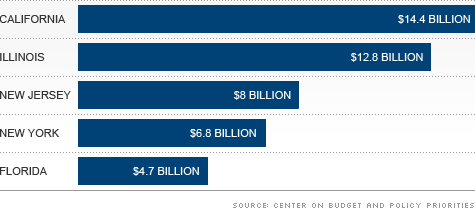More And More States On Budget Brink.
California Has The Largest Projected Budget Gap For Fiscal 2011 But Four Other Key States Are Also Facing Big Problems.
By Colin Barr, Fortune | 20 January 2010

NEW YORK (Fortune)— California is hurtling into the budgetary abyss— and it's not alone.
Across the nation, state tax collections in the first three quarters of 2009 posted their steepest decline in at least 46 years, according to a report this month from the public policy research arm of the State University of New York. At least 30 states raised taxes in their most recently completed fiscal year— which ended in most cases in mid-2009. Even more cut services. All told, states raised $117 billion to fill last year's budget gaps, the Pew Center on the States estimates.
Yet despite all those new taxes and deep cutbacks, pressure on state finances continues to build. Economists warn that without a new round of federal stimulus spending, states could face another round of layoffs that could kneecap an already shaky economic recovery. "We could see a real ripple effect if the states don't take a balanced approach" by balancing cutbacks with tax raises and other new revenue, said Jon Shure, deputy director of the state fiscal project at the Center on Budget and Policy Priorities in Washington.
State and local governments have cut 132,000 jobs since August 2008, the center says. Fiscal problems appear most acute in California, whose general obligation bonds were downgraded this week after Gov. Arnold Schwarzenegger declared a fiscal emergency. The state has already said it will increase tuition by a third in the University of California system, among other cash-raising moves. At one point, by one account, it was projected to spend nearly 50% more than it stands to garner in revenue in this fiscal year. California has asked for federal help and warned it could run out of cash in March.
And California's not the only state facing an almost unfathomable shortfall. Like California, Arizona and Illinois face budget gaps above 40% of projected general fund spending, according to Pew data. Arizona put its state office buildings on sale this week in a bid to raise $700 million.
The University of Illinois furloughed some workers this week after the state failed to come up with $436 million in expected funds. Budget officers in those two states describe their outlooks for fiscal 2010 as "dire," according to a National Conference of State Legislatures report. Alaska, Nevada, New Jersey and New York face gaps of at least 30% of their planned general fund spending by the end of this fiscal year. A dozen more states face a fiscal 2010 budget gap of between 20% and 29%.
"California is playing out on the biggest stage, but there are states around the nation facing problems of equal or greater magnitude," said Corina Eckl, who runs the fiscal affairs program at the National Conference of State Legislatures in Denver. "We are seeing some frightening situations". Big shortfalls scare legislators because states by law must balance their budgets every year. After revenue and spending rose steadily in the middle of this decade, bolstered by a housing bubble that boosted employment and fed a stream of property transfer fees, state funding went into freefall when the recession started at the end of 2007.
Given the depth of the recession, few states are expecting an uptick in employment or consumer spending that would translate into bigger tax collections anytime soon. Nine states are forecasting they won't return to their peak revenue years of 2007 or 2008 until at least 2014. Adding to the pressure, job losses spur demand for the services states devote the lion's share of their budgets to: education and Medicaid, which provides healthcare for low-income people.
"The needs grow as states' ability to meet those needs declines," said economist Andrew Reschovsky, a professor at the University of Wisconsin in Madison. So far, the worst cuts have been avoided with the help of billions of dollars of federal stimulus money— including $135 billion for education and Medicaid. But the flow of those funds will start to slow down in the second half of 2010 and will stop altogether at year-end, unless Congress appropriates more money for state assistance.
States have used $53.6 billion in Medicaid funding through Jan. 8, according to government data. If Congress doesn't extend the Medicaid funding beyond the end of the year, "states are looking at a stimulus cliff," said Robert B. Ward, deputy director of the Rockefeller Institute of Government at the State University of New York at Albany. The only way to make up those shortfalls is through more new taxes, cutbacks and borrowings.
Local and state governments have had little problem borrowing in the bond market, where analysts expect issuance of $400 billion or more this year. California has had to pay higher-than-average interest rates to sell its debt, but there seems to be little fear of a default, given the state's giant economy and its relatively small $64 billion worth of general obligation bonds outstanding.
But borrowing is no help in fixing so-called structural deficits, in which spending exceeds revenue over a prolonged stretch. And so far there has been little sign legislators are willing to make the obligatory tough choices, particularly issuing more or higher taxes [[or making those truly painful cuts: normxxx]]. Many of the so-called fixes for current state deficits are mere Band-Aids that push the problem forward rather than address it, observers said.
"It's surprising that political leaders don't seem to be taking seriously the magnitude of the problems," said Reschovsky. "You would hope it wouldn't come to this, but it might take schools closing and programs being eliminated to create a sense of urgency."
No comments:
Post a Comment